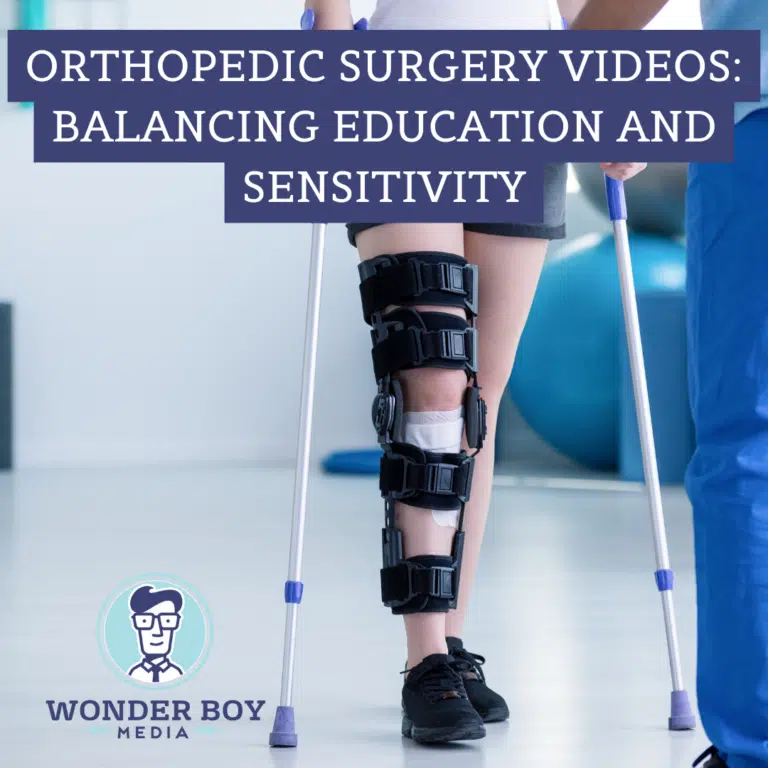Orthopedic surgery videos play a vital role in educating patients, medical professionals, and the general public about complex surgical procedures aimed at improving musculoskeletal health. As an expert in video production within the healthcare sector, we understand the delicate balance required to create informative and sensitive content that respects patient privacy and dignity while providing valuable educational insights. In this in-depth exploration, we’ll delve into the nuances of orthopedic surgery videos, examining how they can effectively balance education and sensitivity to enhance patient understanding and foster trust in the medical profession.
The Significance of Orthopedic Surgery Videos:
Orthopedic surgery encompasses a wide range of procedures aimed at diagnosing, treating, and managing conditions affecting the musculoskeletal system, including bones, joints, ligaments, muscles, and tendons. From joint replacements and spinal surgeries to fracture repairs and sports medicine procedures, orthopedic surgery videos serve as invaluable tools for educating patients, guiding surgical teams, and advancing medical knowledge and techniques.
Balancing Education and Sensitivity:
Orthopedic surgery videos must strike a delicate balance between providing detailed educational content and maintaining sensitivity to patient privacy, dignity, and comfort. While these videos are invaluable for medical education and training purposes, they also have the potential to evoke anxiety, fear, or discomfort in viewers, particularly patients facing upcoming surgical procedures. Therefore, it is essential to approach the creation of orthopedic surgery videos with precision, empathy, and respect for the patient experience.
Best Practices for Creating Orthopedic Surgery Videos:
1. Obtain Informed Consent: Before filming any surgical procedure, obtain informed consent from the patient, ensuring that they understand the purpose of the video, how it will be used, and any potential risks or benefits associated with its production and dissemination.
2. Protect Patient Privacy: Respect patient privacy and confidentiality by obtaining permission to film in the operating room, obscuring or avoiding identifiable patient information, and obtaining consent for any footage that may be used for educational or promotional purposes.
3. Focus on Education: Ensure that orthopedic surgery videos prioritize educational content, providing viewers with a clear understanding of the surgical procedure, its indications, risks, benefits, and expected outcomes. Use visual aids, annotations, and narration to guide viewers through each step of the procedure, highlighting key anatomical structures, surgical techniques, and safety considerations.
4. Emphasize Compassion: Approach the creation of orthopedic surgery videos with empathy and compassion, recognizing that surgical procedures can be daunting and anxiety-provoking experiences for patients. Use language and imagery that is clear, reassuring, and patient-centered, addressing common concerns and providing context for the surgical experience.
5. Include Patient Perspectives: Whenever possible, include perspectives from patients who have undergone similar orthopedic procedures, sharing their experiences, insights, and tips for coping with the surgical process and recovery period. Hearing from fellow patients can provide reassurance and encouragement to individuals facing similar challenges.
6. Provide Resources for Support: Offer resources and support services for patients who may have questions or concerns about the surgical procedure, recovery process, or emotional well-being. Include contact information for patient support groups, counseling services, and educational materials to empower patients to advocate for their own health and well-being.
Real-World Examples:
1. Stanford Medicine Orthopedic Surgery Virtual Reality Experience: Stanford Medicine utilizes virtual reality technology to create immersive orthopedic surgery experiences for medical students, residents, and practicing surgeons. These virtual reality simulations allow users to observe and interact with simulated orthopedic surgeries in a realistic operating room environment, enhancing their understanding of surgical techniques and anatomical structures. By providing hands-on learning experiences in a virtual setting, Stanford Medicine empowers orthopedic surgeons to hone their skills and improve patient outcomes.
2. Hospital for Special Surgery Patient Education Videos: Hospital for Special Surgery, a leading orthopedic hospital, produces patient education videos on orthopedic conditions, treatments, and surgical procedures. These videos feature interviews with orthopedic surgeons, physical therapists, and patients, providing valuable insights and information to individuals considering orthopedic surgery.
Conclusion:
Orthopedic surgery videos play a crucial role in educating patients, medical professionals, and the general public about complex surgical procedures aimed at improving musculoskeletal health. By balancing education and sensitivity, these videos can provide valuable insights into surgical techniques, treatment options, and patient experiences while respecting patient privacy, dignity, and comfort. As an expert in video production within the healthcare sector, we are committed to helping orthopedic surgery videos navigate this delicate balance, ensuring that they serve as informative, empathetic, and empowering resources for patients and healthcare professionals alike. By following best practices, learning from real-world examples, and prioritizing patient-centered care, orthopedic surgery videos can continue to enhance patient understanding, foster trust in the medical profession, and promote optimal outcomes for individuals facing musculoskeletal challenges.
